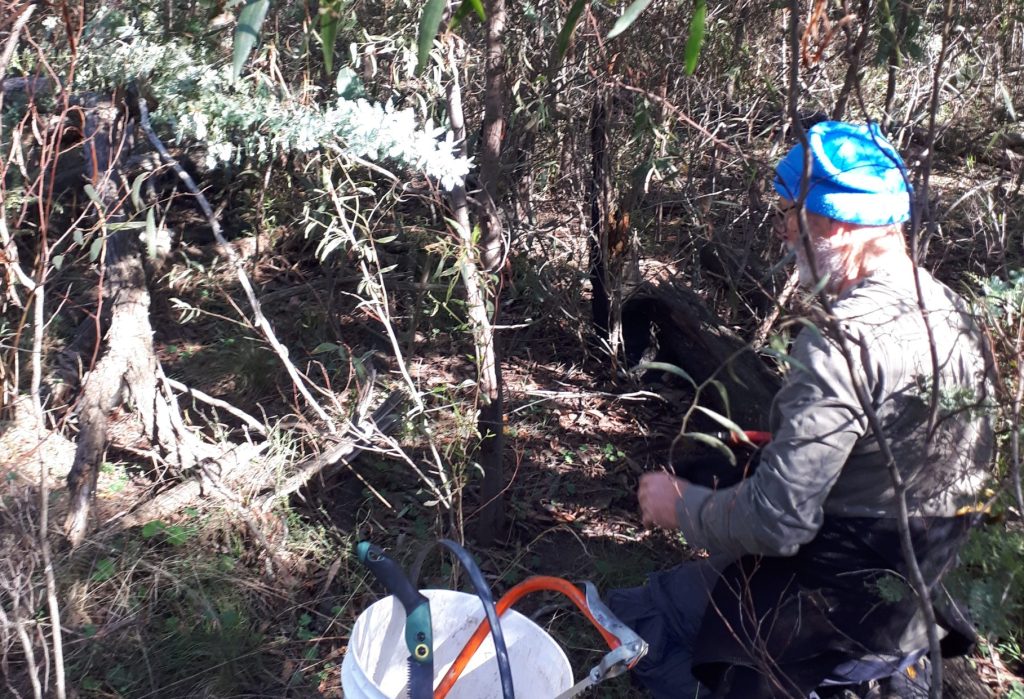Warby Ovens National Park staff indicated to Friends of Warby Ovens National Park (FOWONP) that something useful we could do is remove Cootamundra Wattle from the Killawarra Forest section of the Park.
FOWONP has taken up the challenge. The first working bee on 18 April 2023 was attended by 7 people and used frilling, cutting and painting, and uprooting to destroy Cootamundra Wattles extending along Irishtown Creek from the south-western edge of the forest. At least 300 plants were removed, and more were located to be dealt with in future.
What is Cootamunda Wattle and why is it a problem?

Cootamundra Wattle (Acacia baileyana) is a commonly planted Australian native plant with bright yellow, fragrant flowers and pale silvery-blue leaves. Around the Warby Ovens National Park, the most similar local native species is Silver Wattle (which of course should be nurtured). You can tell the difference easily by the number of leaflets (called pinnae). Cootamundra Wattle leaves have 8 or fewer pinnae, whereas Silver Wattle leaves have way more (16 to 40). The pair of pinnae closest to the stem point backwards in Cootamundra Wattle leaves but not in Silver Wattle leaves. Also Silver Wattle leaves are often a bit duller green than Cootamundra Wattles. In this region Silver Wattles are more common adjacent to waterways and don’t seem to occur much at all in Killawarra Forest.
Cootamundra Wattle has escaped from gardens in all Australian states, invading woodlands and forests in drier areas where annual rainfall exceeds 400mm. It is considered a weed in Victoria. It has seeds that live at least 10 years in the soil and are triggered to grow especially after fire. Dense stands of Cootamundra Wattle will crowd out local native shrubs and ground-storey plants and also impede overstorey regeneration.[1]
While the infestation at Killawarra Forest is currently scattered, after fire or disturbance around mature plants, seedling growth is dense. Without control the light infestation there would gradually become denser, but if a fire goes through, the infestation could rapidly become very dense, depending on how much seed there is stored in the soil.
Long term control of Cootamundra Wattle is really about minimising the amount of seed stored in the soil. Ideally we would remove all existing plants before they seed again in Spring. Even if we did this, control of this species will need to go on for at least 10 years while the stock of seeds in the soil is exhausted. If any seed is added to the soil in the meantime, control will need to be extended. If FOWONP is committed to this project, after eliminating all adult plants, annual visits to the Killawarra Forest will be needed to target young plants.
How did it get there?
Its not all that clear how Cootamundra Wattle got to establish the pattern of infestation in the Killawarra. The infestation is scattered, and on the drainage lines and ridges so seed hasn’t always been carried by water. Nor is the seed wind-borne. But something is scattering the seed. I think the most likely culprit is Sulphur-crested Cockatoos, which I have seen feasting on and carrying away Silver Wattle seed pods which are similar. I imagine they would do the same with Cootamundra Wattle seeds, dropping some along the way. Cockatoos are messy feeders and do drop a significant proportion of their food.
Concern has been expressed that by removing Cootamundra Wattle we are removing nesting and feeding habitat for birds. In the short term this may be true to some extent, although there is plenty of local native wattle growth in the Killawarra Forest currently to support birds. However in the medium and long term Cootamundra Wattle is replacing nesting and feeding habitat for birds provided by the local natives, not supplementing it. And removing Cootamundra Wattle will allow the local natives to prosper and replace the habitat provided by the Cootamundra Wattle. Also, Cootamundra Wattle infestations tend to be a monoculture, which support fewer species of animals too. So controlling Cootamundra Wattle will allow the diversity of other local native plants to thrive, and with them the full diversity of native animals.
How can I help?
- Attend the next working bee.
- Especially if you are close to any areas where Cootamundra Wattle could spread, don’t plant Cootamundra Wattle in your garden, or on your property, and if you have it, remove it, and replace it with Silver Wattle.
- Encourage others to remove Cootamundra Wattle also.
[1] Bush Invaders of South-East Australia by Adam Muyt




